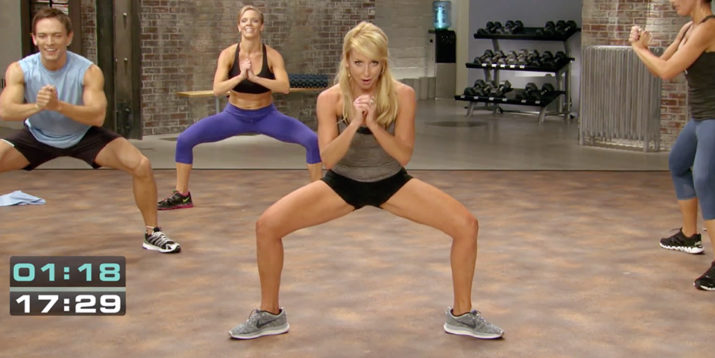How to Do a Sumo Squat (Video)

Few other moves engage as many muscles below the waist as the traditional squat, making it one of the most effective exercises for building lower-body strength and power. So you may wonder, “Is the sumo squat just messing with perfection?” Turns out that variety isn’t just the spice of life — it will also keep your workouts interesting and effective, explains Trevor Thieme, C.S.C.S., senior fitness and nutrition content manager for Beachbody.
“If your workout program only contains one kind of squat, you’re shortchanging your lower-body strength gains,” he says. Incorporating the sumo squat into your workouts will still give you all the benefits of a standard squat, plus a few more.
The difference between the sumo squat and the traditional squat comes down to foot placement. Proper sumo squat form requires the feet to be wider than shoulder-width and the toes to be turned slightly away from the body.
Like the traditional squat, the sumo works the quads and glutes, but its wider stance offers an additional advantage. “The sumo squat also emphasizes your inner-thigh adductors, which are responsible for moving your legs toward the midline of your body,” says Thieme.
Ready to up your squat game? Step outside your comfort zone (aka hip- to shoulder-width position) and into a sumo squat.
How to Do the Sumo Squat With Perfect Form
Appears in: PiYo >> Buns
- Stand with your feet wider than your shoulders and your arms at your sides. Turn your feet slightly outward. This is the starting position.
- Keeping your chest up and core engaged, push your hips back, bend your knees, and lower your body until your thighs are at least parallel to the floor. As you squat down, bring your hands together in front of your chest.
- Pause, and then return to the starting position.
How to Make the Sumo Squat Easier
If you find the bodyweight sumo squat too challenging, you can make it easier by decreasing your range of motion — only drop a quarter to half of the way down.
How to Make the Sumo Squat Harder
You can increase the difficulty of the sumo squat by adding resistance. To do a dumbbell sumo squat, hold two dumbbells of equal weight in front of your waist with straight arms, and lower them between your legs as you lower your body. Alternatively, you can perform a goblet sumo squat: Hold a kettlebell by the horns (i.e., each side of the handle) or single dumbbell (cup one end in both hands) at chest height. Yet another option is the barbell sumo squat, performed with a barbell held securely across your upper back and shoulders.
No access to weights? Challenge yourself by slowing down the pace of the movement or pausing for 2 to 4 seconds at the bottom of the squat.
Benefits of the Sumo Squat
Squatting is a basic functional movement — you do it every time you sit in a chair, pick up something off the floor (at least you should), or visit the loo. So it makes sense to learn correct form and strengthen all of the muscles required to do it. Beyond reinforcing proper squatting mechanics (e.g., flat back, chest up, initiating the movement by pushing the hips back, etc.), the sumo squat can help build strength and muscle mass in the glutes, quads, and inner thighs. And if you want to improve the definition of your butt and legs, you need to enhance the musculature of your glutes and quads.
When performed in high volume, the sumo squat is a great movement option for a high-intensity interval training (HIIT) workout. Because the move recruits multiple large muscle groups in the legs, glutes, and core, its calorie-burning potential is high.
What Muscles Does the Sumo Squat Work?
Quads
The quadriceps are four distinct muscles on the front of your thighbone (femur) that are responsible for straightening your leg: the rectus femoris, the vastus lateralis, the vastus medialis, and the vastus intermedius.
Glutes
These are your butt muscles. The gluteus maximus, which is the largest of the three, is the one most responsible for the shape and prominence of your backside, as well as extension of the leg. The gluteus medius, located toward the outer edges of your rear, handles lateral rotation and abduction (extension out to the sides) of your leg. Finally, the gluteus minimus similarly rotates the leg and also helps stabilize the pelvis.
Adductors
These ropy muscles on the insides of your thighs are responsible for bringing your legs together.
